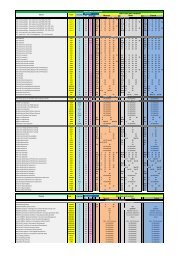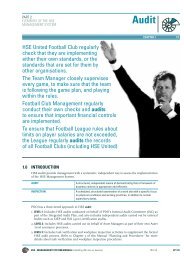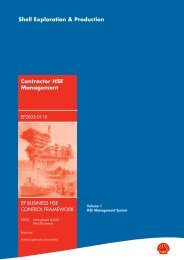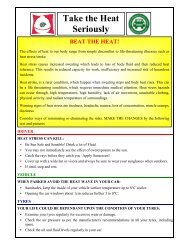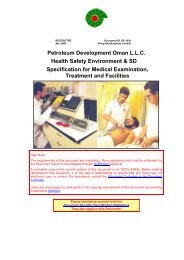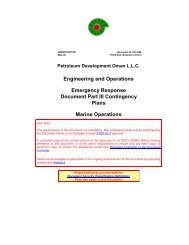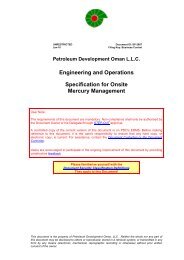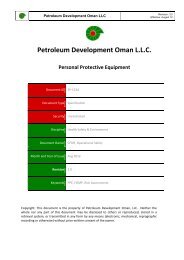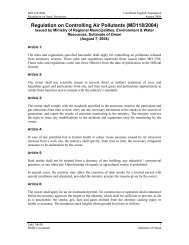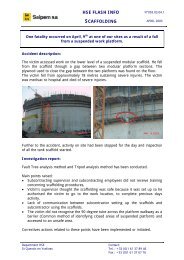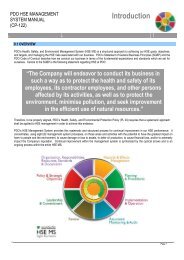Estate Service Asset - PDO
Estate Service Asset - PDO
Estate Service Asset - PDO
You also want an ePaper? Increase the reach of your titles
YUMPU automatically turns print PDFs into web optimized ePapers that Google loves.
Petroleum Development Oman<br />
<strong>Estate</strong> <strong>Service</strong>s <strong>Asset</strong><br />
Environmental Assessment<br />
2002 Review and Update<br />
5.9.3 Sediment Flora and Fauna<br />
The coast has unstable sand substrates, which produce high turbidity leading to poor<br />
underwater light penetration. Such turbid conditions limit sea flora populations, such<br />
as sea grasses. The direct grazers on sea grasses include the green turtle Chelonia<br />
mydas, parrot fish and sea urchins. In Oman, there are four species of sea grass, the<br />
smaller Halodule uninervis and Halophila ovalis and the larger Thalassodendron<br />
ciliatum and Syringodium isoetifolium which form limited beds. In shallow water<br />
sediments along the coast, the typical infauna found include polychaetes, snails, olive<br />
shells, cowries, sand dollars and heart urchins. Very little is known about the deeper<br />
subtidal infauna of coastal areas of the Gulf of Oman. A variety of benthic<br />
macrofauna including polychaetes, molluscs, echinoderms can be expected to inhabit<br />
the deeper coastal zone.<br />
Recent studies in MAF bay showed generally low levels of hydrocarbons and heavy<br />
metals in intertidal beach samples, with the exception of vanadium. The subtidal<br />
sediment samples in general indicated no contaminated. The sediment samples taken<br />
from single buoy mooring locations were found to contain high levels of copper and<br />
tributyl tin, possibly due to the use of antifouling paints.<br />
5.9.4 Fish Communities<br />
The predominant pelagic species include the most important commercial fish in<br />
Oman, viz., the kingfish (Scomberomorus commerson), tunas and mackerel<br />
(Scombridae), the scad (Decapterus russelli, Sardinella longiceps and Selar<br />
crumenophthalamus) and others in the 20 to 100 m depth range. Other commercially<br />
important demersal species here include croakers (Sciaenidae), snappers (Lutjanidae),<br />
jacks (Carangidae), barracudas (Sphyraenidae), and emperors (Lethrinidae).<br />
5.9.5 Turtles<br />
There are five kinds of marine turtles found off the coasts of Oman; the Green Turtle<br />
Chelonia mydas, the Hawksbill Eretmochelys imbricata, the Olive Ridley<br />
Lepidochelys olivacea, the Loggerhead Caretta caretta and the Leatherback Turtle<br />
Dermochelys coriaca. The Green Turtle and the Hawksbill are regarded as<br />
“endangered”. Both endangered species use the Dimaniyat Islands as a nesting<br />
ground.<br />
©HMR Environmental Engineering Consultants C5 - 7<br />
Oman’s Environmental Consultancy<br />
HMR\1501\<strong>Estate</strong> <strong>Service</strong>s



